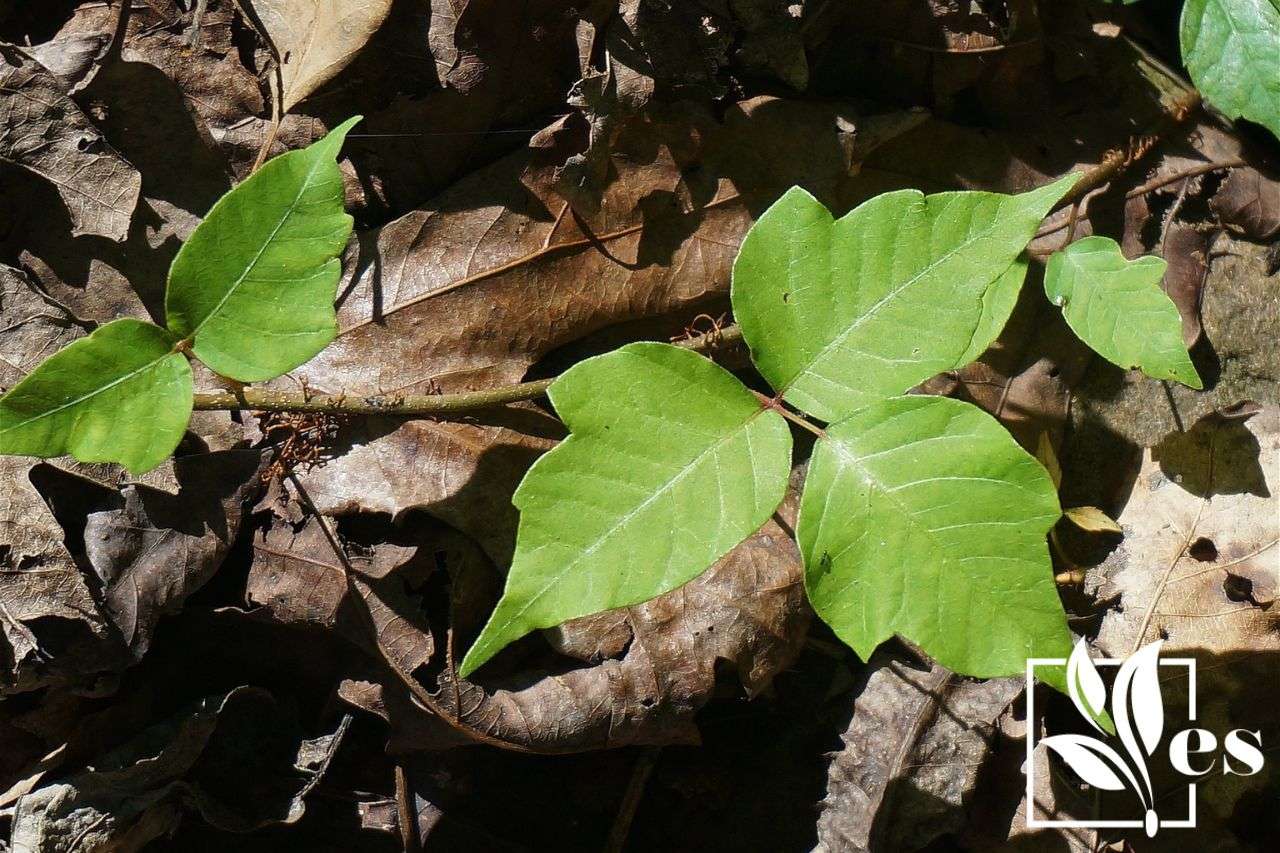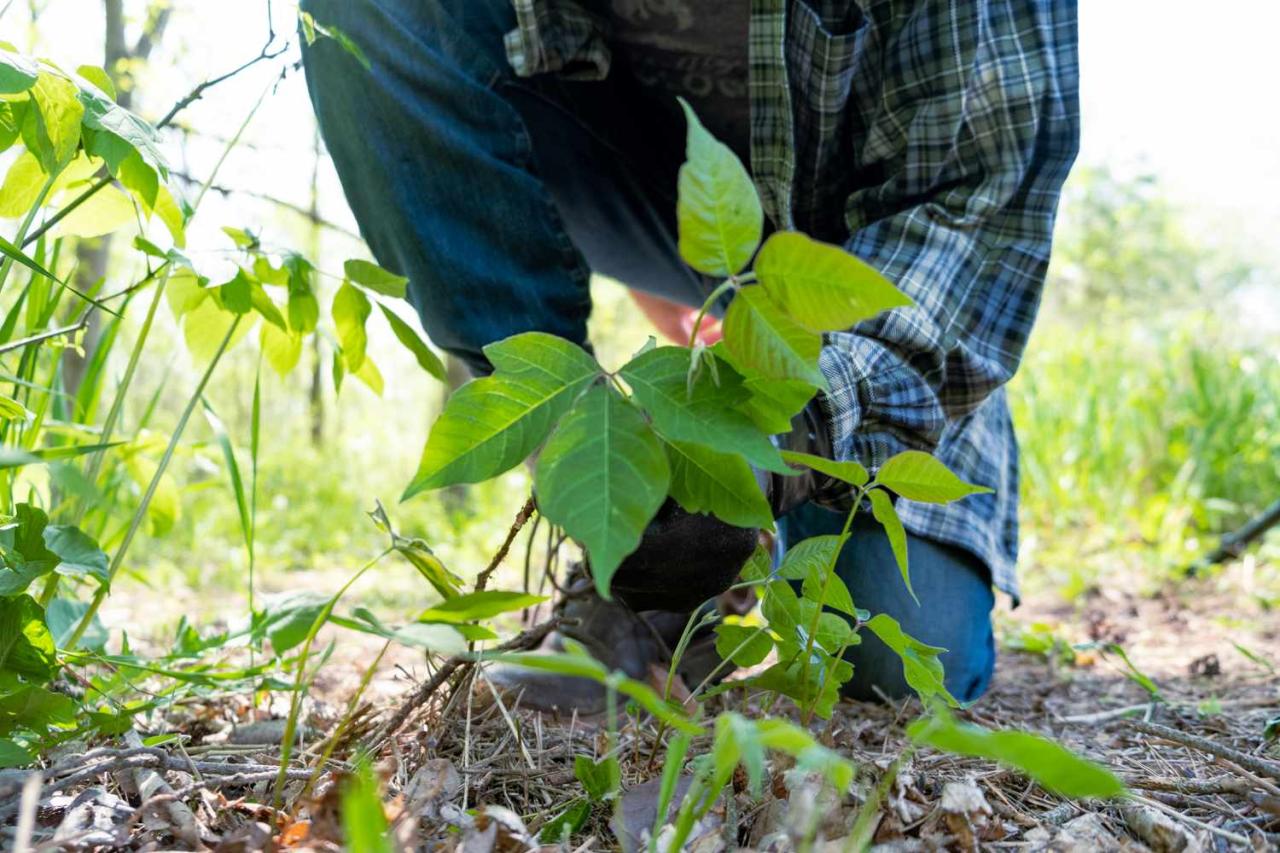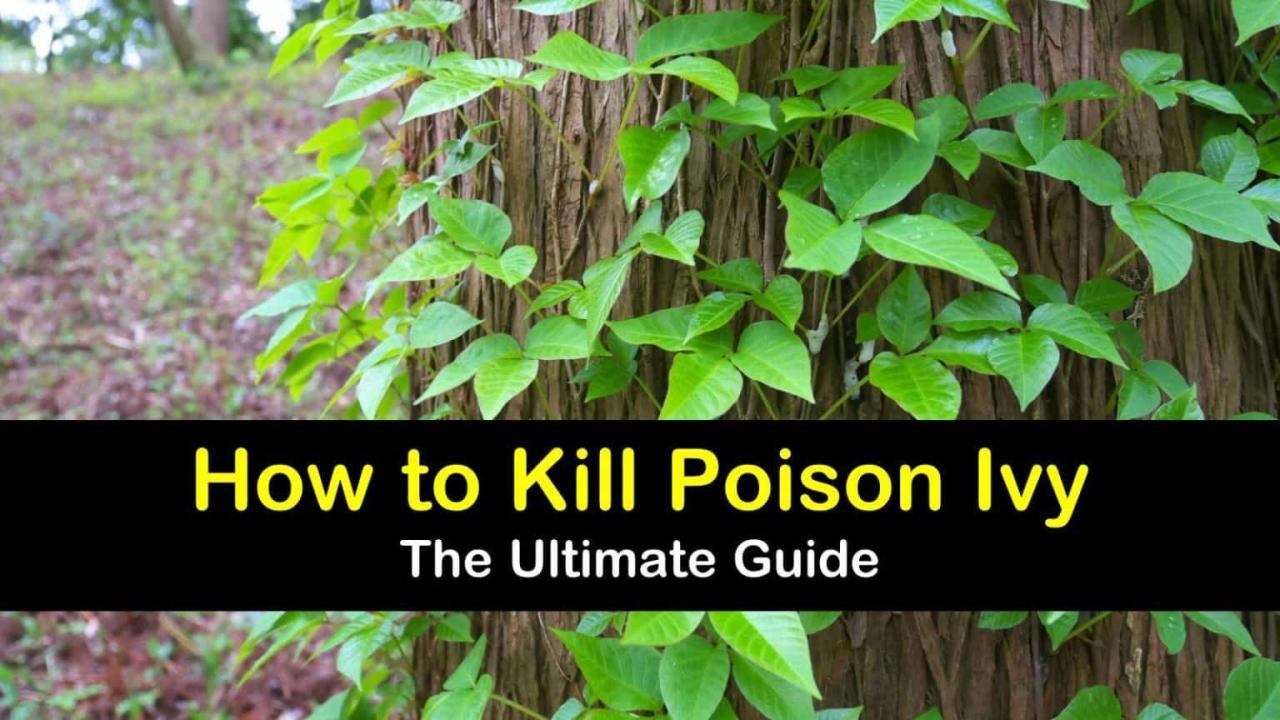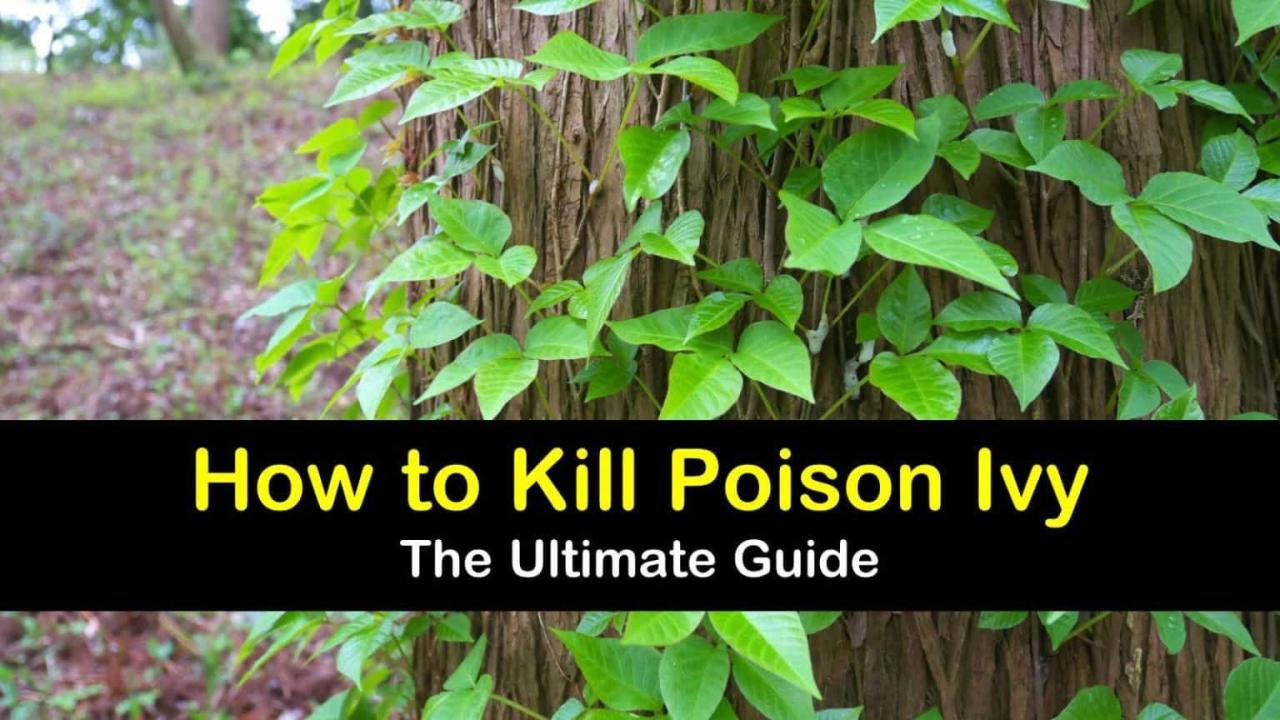How to Control Poison Ivy Growth Near Trees Without Root Damage is a common concern for homeowners and gardeners, as poison ivy’s tenacious vines can quickly overwhelm desirable plants and even damage trees. The key to successful control lies in understanding poison ivy’s growth habits and employing methods that target the plant without harming surrounding trees.
This guide provides a comprehensive approach, covering everything from manual removal and herbicide application to natural remedies and preventive measures.
By combining knowledge of poison ivy’s characteristics and effective control techniques, you can effectively manage this pesky plant while protecting your valuable trees.
Understanding Poison Ivy and Its Growth Habits
Poison ivy, a common plant in North America, is notorious for its irritating sap, which causes an itchy, blistering rash in most people. Understanding its growth habits is crucial for effective control and preventing accidental contact.
Identifying Poison Ivy
Poison ivy is a climbing vine or shrub with distinctive characteristics that help differentiate it from other plants. It has three leaflets, hence the saying, “Leaves of three, let it be.” These leaflets are usually glossy green, turning red or orange in autumn.
The plant also produces small, white berries in clusters. While its appearance can vary slightly depending on the environment, the three-leaflet pattern is the most reliable identifying feature.
Growth Patterns and Preferred Environments
Poison ivy thrives in various environments, including:
- Forest edges:Poison ivy often grows along the borders of forests, where it can climb trees for sunlight.
- Open areas:It can also be found in open fields, meadows, and roadsides, where it can grow as a groundcover.
- Disturbed areas:Poison ivy is often found in disturbed areas, such as construction sites, abandoned fields, and along fence lines.
Factors Contributing to Spread
The spread of poison ivy is facilitated by several factors, including:
- Seed dispersal:Birds and other animals eat the berries and disperse the seeds through their droppings.
- Root systems:Poison ivy has a shallow, extensive root system that can send up new shoots from broken roots or root fragments.
- Human activity:Disturbances, such as mowing, tilling, or construction, can spread poison ivy by breaking up the roots and dispersing the seeds.
Methods for Controlling Poison Ivy Growth

Controlling poison ivy growth near trees requires careful consideration to avoid damaging the trees’ root systems. Various methods are available, each with its advantages and drawbacks.
Manual Removal
Manual removal involves physically digging up or pulling out poison ivy plants. This method is effective for small infestations and can be a good option for those who prefer a chemical-free approach.
- Safety Precautions:Always wear protective clothing, including gloves, long sleeves, and long pants, to prevent skin contact with the plant’s oils.
- Step-by-Step Guide:
- Identify the poison ivy plants and mark their location.
- Use a shovel or hand trowel to dig up the plants, ensuring you remove the entire root system.
- Dispose of the plants properly by burning them (with caution) or bagging them in sealed plastic bags for disposal in a landfill.
- Limitations:Manual removal can be labor-intensive and time-consuming, especially for large infestations. It may also be challenging to remove all roots, leading to regrowth.
Herbicides
Herbicides are chemical solutions designed to kill plants. They can be effective for controlling poison ivy growth, but their use should be carefully considered due to potential risks to the environment and human health.
- Types of Herbicides:There are various types of herbicides available, including broadleaf herbicides, systemic herbicides, and contact herbicides. Each type works differently and has different levels of effectiveness and toxicity.
- Application Techniques:Herbicides can be applied in various ways, including spraying, spot treatment, and soil application.
- Risks:Herbicides can harm beneficial plants, contaminate water sources, and pose health risks to humans and animals. Always read and follow the manufacturer’s instructions carefully, and wear appropriate protective gear when handling herbicides.
Natural Remedies
Natural remedies for controlling poison ivy growth include using vinegar, salt, and boiling water. These methods can be effective in some cases but often require repeated applications and may not be as effective as other methods.
- Vinegar:Vinegar is a natural herbicide that can kill poison ivy plants. However, it may also damage other plants, and repeated applications may be necessary for complete eradication.
- Salt:Salt can dehydrate poison ivy plants, but it can also harm the soil and surrounding vegetation.
- Boiling Water:Pouring boiling water on poison ivy plants can kill them, but this method can also damage the surrounding soil and plants.
Protecting Trees from Root Damage

While herbicides can be effective in controlling poison ivy, it’s crucial to protect nearby trees from potential root damage. Herbicides can be absorbed by tree roots, leading to stunted growth, leaf discoloration, and even death.
Minimizing Root Damage, How to Control Poison Ivy Growth Near Trees Without Root Damage
Herbicides can be absorbed by tree roots, leading to stunted growth, leaf discoloration, and even death. It’s essential to use herbicides cautiously around trees, taking steps to minimize root damage.
- Apply herbicides selectively:Aim for direct contact with poison ivy, avoiding contact with tree trunks and the surrounding soil. This minimizes the risk of herbicide absorption by tree roots.
- Use a shield or barrier:A cardboard shield or a plastic tarp can be placed around the base of the tree to prevent herbicide spray drift and contact with tree roots.
- Choose a low-impact herbicide:Some herbicides are formulated to be less toxic to trees and other plants. Consult with a local nursery or garden center for recommendations on low-impact herbicides suitable for your specific situation.
- Apply herbicides in the fall or winter:When trees are dormant, their roots are less active and less likely to absorb herbicides.
- Avoid applying herbicides during periods of heavy rain:Rain can wash herbicides into the soil, increasing the risk of root damage.
Selective Herbicide Application
Selective herbicide application involves targeting poison ivy while minimizing contact with trees.
- Spot treatment:Applying herbicides directly to poison ivy plants using a hand-held sprayer or a paintbrush. This method allows for precise application and reduces the risk of herbicide drift.
- Foliar application:Applying herbicides to the leaves of poison ivy plants. This method is effective for controlling poison ivy that is growing in dense areas, but it’s essential to use caution to avoid spraying nearby trees.
- Cut-stump treatment:Applying herbicides to the cut stumps of poison ivy plants. This method is effective for controlling poison ivy that has been cut down, but it’s important to ensure that the herbicide is applied to the cut surface and not to the surrounding soil.
Controlling poison ivy growth near trees requires careful consideration to avoid damaging the tree’s root system. One method is to use a targeted herbicide, but it’s crucial to apply it precisely to the poison ivy and avoid spraying the tree’s trunk or roots.
For a more natural approach, consider using a thick layer of mulch around the base of the tree to suppress poison ivy growth. Similarly, natural insect repellents can be used to deter pests without harming beneficial insects. For example, a solution of diluted dish soap and water can effectively control gnats in plants, as detailed in How to Use Natural Insect Repellents to Get Rid of Gnats in Plants.
These strategies can help keep your trees healthy while effectively managing poison ivy growth.
Natural Barriers
Natural barriers can help prevent poison ivy from encroaching on tree roots.
Controlling poison ivy growth near trees requires careful consideration to avoid damaging the roots. One effective method involves using a targeted herbicide, but it’s crucial to apply it only to the poison ivy and not the tree. Just like maintaining the optimal water temperature for air plants, The Perfect Water Temperature for Air Plants , is vital for their health, precise application of herbicide is essential for controlling poison ivy while protecting the tree’s root system.
- Mulch:A layer of mulch around the base of trees can help suppress poison ivy growth and prevent it from spreading to the roots. Wood chips, shredded bark, and straw are effective mulching materials.
- Groundcover plants:Planting groundcover plants that are competitive with poison ivy can help to suppress its growth. Some effective groundcover plants include creeping phlox, pachysandra, and periwinkle.
- Densely planted shrubs:Planting densely planted shrubs around trees can help to create a physical barrier that prevents poison ivy from reaching the tree roots.
Soil Management Practices
Proper soil management practices are crucial for promoting healthy tree growth and minimizing the spread of poison ivy.
- Regular watering:Ensuring that trees are adequately watered can help to promote healthy root growth and make them less susceptible to poison ivy encroachment.
- Soil aeration:Aerating the soil around trees can improve drainage and make it more difficult for poison ivy to thrive.
- Soil testing:Regularly testing the soil pH and nutrient levels can help to identify any deficiencies that could make trees more vulnerable to poison ivy infestation.
Prevention Strategies
Preventing poison ivy growth from the start is the most effective way to manage this pesky plant. By understanding its growth habits and taking proactive steps, you can minimize the risk of encountering its irritating oils.
Maintaining a Healthy Lawn
A healthy lawn can act as a barrier against poison ivy growth. A thick, dense lawn makes it difficult for poison ivy to establish itself.
- Regular Mowing:Keep your lawn mowed regularly, especially during the growing season. This prevents poison ivy from reaching maturity and producing seeds.
- Proper Fertilization:Provide your lawn with the necessary nutrients to promote healthy growth. A healthy lawn can outcompete poison ivy for resources.
- Watering:Ensure your lawn receives adequate water, especially during dry periods. A well-hydrated lawn is less susceptible to weed invasion.
Landscaping and Garden Design
Strategic landscaping and garden design can help prevent poison ivy from taking hold.
- Plant Barriers:Consider planting dense shrubs or groundcovers around areas where poison ivy might grow. These can act as physical barriers and prevent its spread.
- Spacing:When planting new trees or shrubs, allow adequate space between them to prevent overcrowding. This provides better air circulation and reduces the chance of poison ivy taking root.
- Mulch:Use mulch around trees and shrubs to suppress weed growth, including poison ivy. Mulch can also help retain soil moisture.
Seasonal Prevention
Poison ivy is most active during the spring and fall. Taking preventative measures during these seasons can help control its growth.
- Spring:During the spring, as new growth emerges, carefully inspect your property for poison ivy. Remove any seedlings or new growth immediately.
- Fall:In the fall, before the leaves drop, remove any existing poison ivy plants. This prevents them from spreading seeds and establishing new colonies.
Long-Term Management and Maintenance: How To Control Poison Ivy Growth Near Trees Without Root Damage

Controlling poison ivy growth around trees is an ongoing process that requires consistent vigilance and proactive measures. Once you have successfully eradicated the poison ivy, it is crucial to implement a long-term management plan to prevent its resurgence and protect your trees.
This plan involves regular inspections, ongoing weed control, and safe disposal of any remaining poison ivy.
Regular Inspections and Maintenance
Regular inspections are essential to detect any new poison ivy growth before it becomes a significant problem. These inspections should be conducted at least once a month, especially during the growing season, which typically runs from spring to fall. Pay particular attention to areas where poison ivy has previously been removed, as it can quickly re-emerge from dormant roots or seeds.
- Focus on areas around the base of the trees, along tree trunks, and in the surrounding ground where poison ivy has been removed.
- Look for new shoots, leaves, and vines, even small ones. Remember that poison ivy can be identified by its characteristic three-leaf pattern and its glossy, sometimes hairy leaves.
- Use a magnifying glass or a smartphone camera with a macro mode to help you identify small seedlings.
Ongoing Weed Control
After removing poison ivy, it is important to maintain a weed-free environment to prevent its return. This involves regular weed control practices that target not only poison ivy but also other weeds that can compete with trees for resources.
- Mulching:Applying a thick layer of mulch around the base of trees can help suppress weed growth, including poison ivy. Mulch can be made from organic materials like wood chips, shredded bark, or compost. It helps to maintain soil moisture, regulate temperature, and prevent weeds from germinating.
- Hand-Pulling:For small infestations, hand-pulling can be an effective way to remove poison ivy seedlings and small vines. Make sure to wear protective clothing, gloves, and eye protection to avoid contact with the plant’s sap. Dispose of the pulled poison ivy properly to prevent its spread.
- Herbicides:In cases of larger infestations or where hand-pulling is not feasible, herbicides can be used to control poison ivy. Choose herbicides specifically formulated for weed control around trees and follow the manufacturer’s instructions carefully. Herbicides should be applied with caution, and only when necessary, to minimize potential damage to the trees.
Safe Disposal of Poison Ivy
Proper disposal of poison ivy is essential to prevent its spread. Avoid simply throwing it in the trash or composting it, as this can allow the plant to spread through seeds or roots. Here are some safe disposal methods:
- Burning:Burning poison ivy is not recommended, as the smoke can irritate the respiratory system and spread the plant’s oils through the air.
- Double-Bagging:If you are disposing of poison ivy in the trash, double-bag it in thick, heavy-duty garbage bags. Secure the bags tightly with tape to prevent leaks. Label the bags clearly as “Poison Ivy” to warn others.
- Chemical Treatment:Some herbicides can be used to kill poison ivy before disposal. Consult with a local nursery or landscaping professional for recommendations on effective herbicides for this purpose.
Closure
Successfully controlling poison ivy growth near trees requires a multifaceted approach that balances effectiveness with safety. By understanding poison ivy’s growth habits, utilizing appropriate control methods, and implementing preventive measures, you can minimize the risk of this invasive plant while maintaining a healthy landscape.
Remember, consistent monitoring and maintenance are crucial for long-term success in keeping poison ivy at bay.
Questions and Answers
What is the best time of year to control poison ivy?
Spring and fall are generally considered the best times for controlling poison ivy, as the plant is actively growing during these seasons. However, you can control poison ivy year-round, especially if you use herbicides.
Can I use a weed trimmer to control poison ivy?
Using a weed trimmer on poison ivy is not recommended, as it can spread the plant’s oils and increase the risk of skin irritation. It’s best to use manual removal or herbicides for control.
How long does it take for poison ivy to die after treatment?
The time it takes for poison ivy to die after treatment varies depending on the method used. Manual removal may require repeated applications, while herbicides can provide faster results. It’s important to follow the instructions on herbicide labels carefully.
Is it safe to burn poison ivy?
Burning poison ivy is not recommended, as the smoke can contain the plant’s oils and cause respiratory problems. It’s best to use other methods for control.
